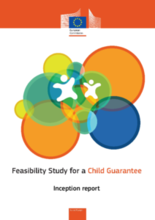In 2015, the European Parliament called on the European Commission and the European Union Member States, “in view of the weakening of public services, to introduce a Child Guarantee so that every child in poverty can have access to free healthcare, free education, free childcare, decent housing and adequate nutrition, as part of a European integrated plan to combat child poverty”. Following the subsequent request by the Parliament to the Commission to implement a Preparatory Action to explore the potential scope of a Child Guarantee for vulnerable children, the Commission ordered a study to analyse the feasibility of such a scheme. The feasibility study for a Child Guarantee is carried out by a consortium consisting of Applica and the Luxembourg Institute of Socio-Economic Research (LISER), in close collaboration with Eurochild and Save the Children, and with the support of nine thematic experts, 28 national experts and an independent study editor.
This Inception Report is the first deliverable of the Feasibility Study for a Child Guarantee (FSCG). It is intended to set the scene for the work that will follow over the next 16 months. Based on the limited evidence available, this report provides a first mapping of the situation across the 28 Member States outlining the situation in relation to children, particularly the four target groups (TGs) of disadvantaged children (children in institutions, children with disabilities, children of recent migrants and refugees, and children living in precarious family situations) as well as an indication of the key issues in relation to children’s access to the five policy areas (PAs): housing, healthcare, nutrition, early childhood education and care, and education. It also provides an initial indication of key policy questions to be discussed during the process and, in particular, at the fact-finding workshops, a clear description of the process and timeline that will be followed in implementing the project, and an outline of all the ways and moments when stakeholders will have an opportunity to contribute to the process.
In Section 2, the key concepts and definitions in relation to the four TGs and five PAs are outlined. Section 3 discusses the availability of empirical evidence. Section 4 provides a mapping of the situation in relation to the four TGs and five PAs. Section 5 presents a mapping of the main international and EU policy instruments relevant to children’s rights. Section 6 describes the content and purpose of the different deliverables that will be produced and the key activities that will take place as part of the FSCG and how they are interconnected. Section 7 sets out the timetable for all the deliverables and activities. Section 8 explains how the FSCG is represented on the Commission website. Section 9 outlines the key issues and questions to be addressed during the course of the FSCG. Section 10 indicates the expected outcomes of the FSCG. Section 11 gives details of the consortium managing the FSCG, the coordinating team and all the experts involved in the FSCG.
The report includes a table on the number of children in institutions in Europe (page 14) and a subsequent table on page 16 on the estimated number of children with disabilities in institutions.

